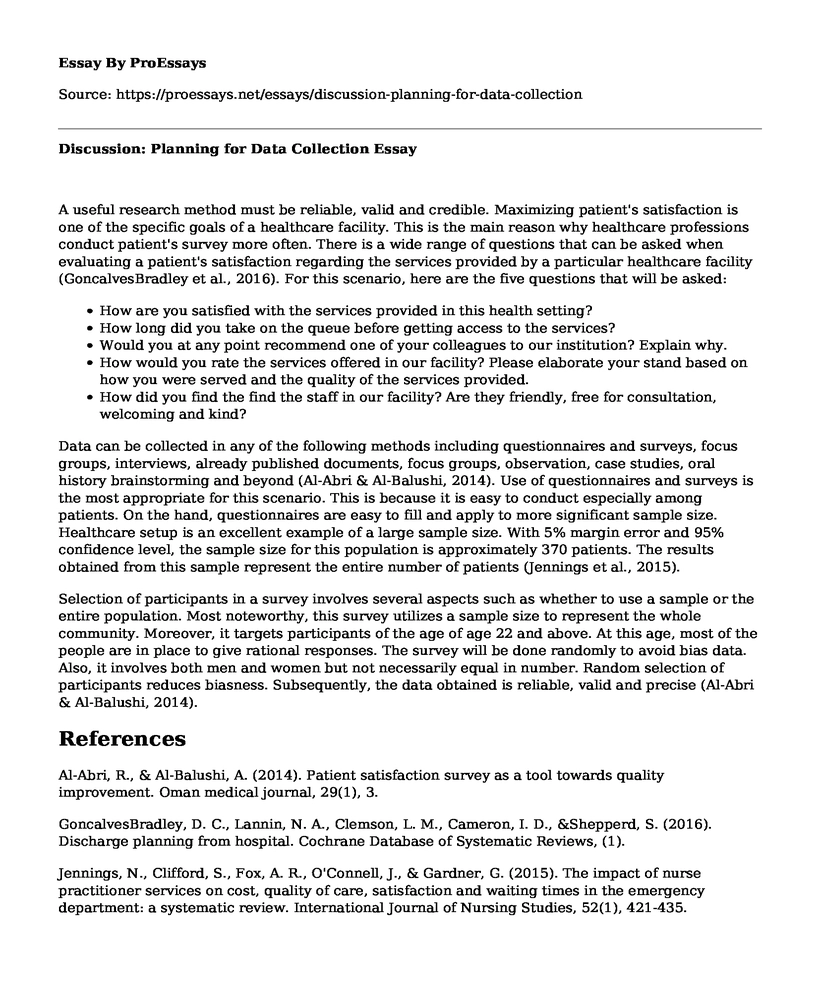A useful research method must be reliable, valid and credible. Maximizing patient's satisfaction is one of the specific goals of a healthcare facility. This is the main reason why healthcare professions conduct patient's survey more often. There is a wide range of questions that can be asked when evaluating a patient's satisfaction regarding the services provided by a particular healthcare facility (GoncalvesBradley et al., 2016). For this scenario, here are the five questions that will be asked:
- How are you satisfied with the services provided in this health setting?
- How long did you take on the queue before getting access to the services?
- Would you at any point recommend one of your colleagues to our institution? Explain why.
- How would you rate the services offered in our facility? Please elaborate your stand based on how you were served and the quality of the services provided.
- How did you find the find the staff in our facility? Are they friendly, free for consultation, welcoming and kind?
Data can be collected in any of the following methods including questionnaires and surveys, focus groups, interviews, already published documents, focus groups, observation, case studies, oral history brainstorming and beyond (Al-Abri & Al-Balushi, 2014). Use of questionnaires and surveys is the most appropriate for this scenario. This is because it is easy to conduct especially among patients. On the hand, questionnaires are easy to fill and apply to more significant sample size. Healthcare setup is an excellent example of a large sample size. With 5% margin error and 95% confidence level, the sample size for this population is approximately 370 patients. The results obtained from this sample represent the entire number of patients (Jennings et al., 2015).
Selection of participants in a survey involves several aspects such as whether to use a sample or the entire population. Most noteworthy, this survey utilizes a sample size to represent the whole community. Moreover, it targets participants of the age of age 22 and above. At this age, most of the people are in place to give rational responses. The survey will be done randomly to avoid bias data. Also, it involves both men and women but not necessarily equal in number. Random selection of participants reduces biasness. Subsequently, the data obtained is reliable, valid and precise (Al-Abri & Al-Balushi, 2014).
References
Al-Abri, R., & Al-Balushi, A. (2014). Patient satisfaction survey as a tool towards quality improvement. Oman medical journal, 29(1), 3.
GoncalvesBradley, D. C., Lannin, N. A., Clemson, L. M., Cameron, I. D., &Shepperd, S. (2016). Discharge planning from hospital. Cochrane Database of Systematic Reviews, (1).
Jennings, N., Clifford, S., Fox, A. R., O'Connell, J., & Gardner, G. (2015). The impact of nurse practitioner services on cost, quality of care, satisfaction and waiting times in the emergency department: a systematic review. International Journal of Nursing Studies, 52(1), 421-435.
Cite this page
Discussion: Planning for Data Collection. (2022, Sep 18). Retrieved from https://proessays.net/essays/discussion-planning-for-data-collection
If you are the original author of this essay and no longer wish to have it published on the ProEssays website, please click below to request its removal:
- Quantitative, Qualitative and Mixed Methods - Selecting a Research Approach
- Evaluation Essay on Old Spice
- Science Based on Observation Essay
- Visual Attention Lab Report Paper Example
- Structural Equation Modeling and AMOS Paper Example
- Essay on Two-Factor Theory: Herzberg's Research and Criticisms
- IKEA Brand Scorecard Paper Example







